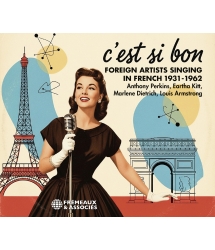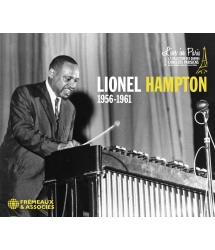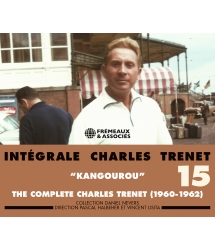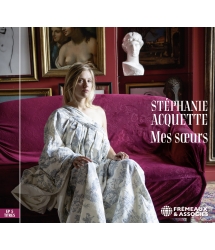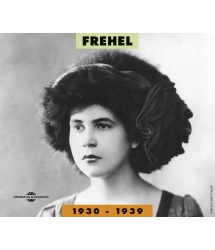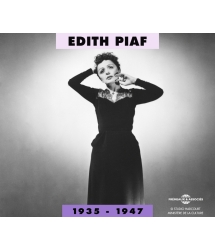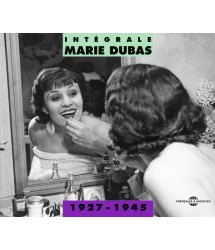- Our Catalog
- Philosophy
- Philosophers of the 20th century and today
- History of Philosophy (PUF)
- Counter-History and Brief Encyclopedia by Michel Onfray
- The philosophical work explained by Luc Ferry
- Ancient thought
- Thinkers of yesterday as seen by the philosophers of today
- Historical philosophical texts interpreted by great actors
- History
- Books (in French)
- Social science
- Historical words
- Audiobooks & Literature
- Our Catalog
- Jazz
- Blues
- Rock - Country - Cajun
- French song
- World music
- Africa
- France
- Québec / Canada
- Hawaï
- West Indies
- Caribbean
- Cuba & Afro-cubain
- Mexico
- South America
- Tango
- Brazil
- Tzigane / Gypsy
- Fado / Portugal
- Flamenco / Spain
- Yiddish / Israel
- China
- Tibet / Nepal
- Asia
- Indian Ocean / Madagascar
- Japan
- Indonesia
- Oceania
- India
- Bangladesh
- USSR / Communist songs
- World music / Miscellaneous
- Classical music
- Composers - Movie Soundtracks
- Sounds of nature
- Our Catalog
- Youth
- Philosophy
- News
- How to order ?
- Receive the catalog
- Manifesto
- Dictionnary











- Our Catalog
- Philosophy
- Philosophers of the 20th century and today
- History of Philosophy (PUF)
- Counter-History and Brief Encyclopedia by Michel Onfray
- The philosophical work explained by Luc Ferry
- Ancient thought
- Thinkers of yesterday as seen by the philosophers of today
- Historical philosophical texts interpreted by great actors
- History
- Books (in French)
- Social science
- Historical words
- Audiobooks & Literature
- Our Catalog
- Jazz
- Blues
- Rock - Country - Cajun
- French song
- World music
- Africa
- France
- Québec / Canada
- Hawaï
- West Indies
- Caribbean
- Cuba & Afro-cubain
- Mexico
- South America
- Tango
- Brazil
- Tzigane / Gypsy
- Fado / Portugal
- Flamenco / Spain
- Yiddish / Israel
- China
- Tibet / Nepal
- Asia
- Indian Ocean / Madagascar
- Japan
- Indonesia
- Oceania
- India
- Bangladesh
- USSR / Communist songs
- World music / Miscellaneous
- Classical music
- Composers - Movie Soundtracks
- Sounds of nature
- Our Catalog
- Youth
- Philosophy
- News
- How to order ?
- Receive the catalog
- Manifesto
- Dictionnary
1948-1958
EDITH PIAF
Ref.: FA5253
EAN : 3561302525327
Artistic Direction : ANDRE BERNARD
Label : Frémeaux & Associés
Total duration of the pack : 1 hours 50 minutes
Nbre. CD : 2
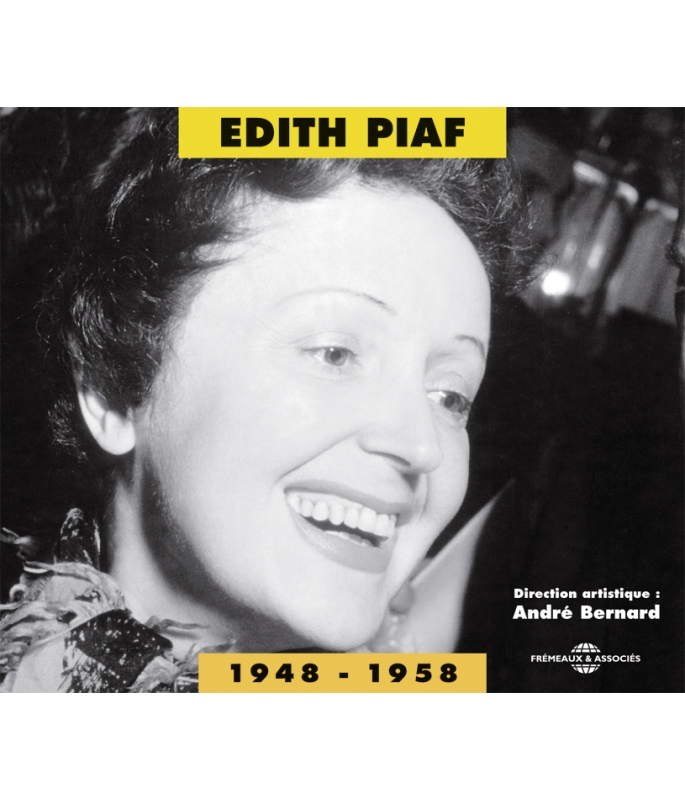
1948-1958
1948-1958
“Edith Piaf remains the very symbol of the French Chanson genre for the whole world. André Bernard's anthology contains her greatest hits from the decade 1948-1958: 36 immortal songs in a 2CD set illustrated by a 32-page booklet.” Patrick Frémeaux
-
PisteTitleMain artistAutorDurationRegistered in
-
1Bal dans ma ruePiaf EdithEmer Michel00:03:001949
-
2Les amants de ParisPiaf EdithFerre Leo00:03:141948
-
3Amour du mois de maiPiaf EdithWal Berg00:02:351948
-
4Cousu de fil blancPiaf EdithEmer Michel00:03:161948
-
5L'orgue des amoureuxPiaf EdithCarco Francis00:03:251949
-
6ParisPiaf EdithBernheim A00:02:431949
-
7C'est d'la faute à tes yeuxPiaf EdithPiaf Edith00:03:201950
-
8Le prisonnier de la tourPiaf EdithBlanche Francis00:03:151949
-
9C'est un garsPiaf EdithAznavour Charles00:03:191950
-
10Hymne à l'amourPiaf EdithJeepy Jean00:03:271950
-
11Tous les amoureux chantentPiaf EdithJeepy Jean00:03:271950
-
12La valse de l'amourPiaf EdithAchard Marcel00:02:181951
-
13Je hais les dimanchesPiaf EdithVeran F.00:03:231951
-
14Si si siPiaf EdithAchard Marcel00:02:201951
-
15La rue aux chansonsPiaf EdithEmer Michel00:02:581951
-
16La chanson de CatherinePiaf EdithDamine Pierre00:03:281951
-
17Plus bleu que tes yeuxPiaf EdithAznavour Charles00:03:131951
-
18Padam padamPiaf EdithGlanzberg N.00:03:161951
-
PisteTitleMain artistAutorDurationRegistered in
-
1A l'enseigne de la fille sans coeurPiaf EdithGilles00:03:261951
-
2JézébelPiaf EdithAznavour Charles00:03:311951
-
3Je t'ai dans la peauPiaf EdithLarue Jacques00:02:481952
-
4Au bal de la chancePiaf EdithLarue Jacques00:02:561952
-
5Les croixPiaf EdithAmade Louis00:03:341953
-
6Pour qu'elle soit jolie ma chansonPiaf EdithPiaf Edith00:03:311953
-
7N'y va pas ManuelPiaf EdithEmer Michel00:03:051953
-
8HeureusePiaf EdithRouzaud Rene00:03:201954
-
9Johnny tu n'es pas un angePiaf EdithLemarque Francis00:02:121953
-
10La goualante du pauvre JeanPiaf EdithRouzaud Rene00:02:031954
-
11Sous le ciel de ParisPiaf EdithDrejac J.00:03:251954
-
12Ca iraPiaf EdithTraditionnel00:02:241954
-
13Les amants d'un jourPiaf EdithDelecluse Claude00:03:171956
-
14C'est à HambourgPiaf EdithDelecluse Claude00:03:041955
-
15Les neiges de FinlandePiaf EdithContet Henri00:01:391958
-
16Marie la FrancaisePiaf EdithLarue Jacques00:03:571956
-
17La foulePiaf EdithRivegauche Michel00:02:581957
-
18Mon manège à moiPiaf EdithConstantin J.00:03:001958
EDITH PIAF 1948 - 1958
EDITH PIAF
1948 - 1958
Direction artistique : André Bernard
Dans notre précédent double CD consacré à Edith Piaf, nous avons évoqué ses créations de 1935 à 1947. Depuis la naissance du disque, aucune chanteuse française n’a obtenu un succès comparable au sien. Sa popularité est telle qu’un public, toutes générations confondues, ne cesse de la découvrir au fil des décennies. Son étoile n’en finit pas de briller, ses chansons jalonnent tous les événements marquants de notre vie. La décennie 1948-1958, couverte par ce second coffret, comporte certains de ses plus grands succès. Pour son premier voyage aux USA en 1947, elle emmène avec elle, aux bras de Jean-Louis Jaubert, les Compagnons de la Chanson pour une série de galas au “Play House” de New-York. Quelques mois plus tard, Edith retourne devant le Public New-Yorkais et triomphe durant 5 mois dans le célèbre cabaret le “Versailles”. Ce sera pour elle la consécration internationale. C’est la rencontre avec le Champion du Monde de boxe Marcel Cerdan et le coup de foudre désormais légendaire entre Edith et Marcel. Tous deux vivent une grande passion mais, le 27 octobre 1949, la belle histoire s’achève tragiquement : Marcel Cerdan est dans l’avion qui s’écrase sur les Açores alors qu’il avait embarqué le matin même au Bourget pour aller la rejoindre à New-York. Edith ne s’en remettra jamais et c’est pour lui qu’elle écrit et interprète “L’Hymne à l’Amour”, son chef-d’œuvre. Piaf triomphe partout où elle chante et les salles affichent complet… Durant ses années difficiles, elle peut compter sur quelques amis proches, particulièrement les duettistes Roche et Aznavour, dont elle a encouragé et guidé les premiers pas. Le duo d’artistes se sépare, mais Charles Aznavour va rester dans l’entourage de Piaf et va devenir une sorte de confident-secrétaire qu’Edith adore. En 1951, Eddie Constantine entre dans la vie de Piaf. Il sera d’abord son amant avant de devenir son partenaire dans “La p’tite Lili” de Marcel Achard sur la scène de l’A.B.C. C’est alors le champion cycliste André Pousse qui succède à Eddie.
En août 1951, alors qu’elle est en tournée sur les routes de France, Piaf est victime d’un terrible accident de voiture aux Baux-de-Provence, avec à ses côtés Charles Aznavour et André Pousse, qui est au volant du véhicule. Edith est grièvement blessée et c’est à partir de ce choc, particulièrement violent, que ses souffrances ne la quitteront plus, malgré les calmants et les piqûres de cortisone. André Pousse sera alors remplacé par un autre cycliste : Toto Gérardin… En 1952, Jacques Pills lui rend visite dans son appartement du Boulevard Pereire pour lui faire écouter “Je t’ai dans la peau”, une chanson dont le compositeur n’est autre que son pianiste François Silly - lequel ne tardera pas à devenir célèbre sous le pseudonyme de Gilbert Bécaud. Jacques Pills, divorcé d’une autre grande dame de la chanson, Lucienne Boyer, demande alors à Edith de l’épouser… Le mariage est célébré aux Etats-Unis, puis le couple s’installe à Paris, dans un bel appartement du Boulevard Lannes. En 1953, elle marque de sa forte personnalité la séquence que lui a réservé Sacha Guitry dans son film “Si Versailles m’était conté…” où elle chante, mieux que personne, le célèbre “Ça ira”, symbole de la Révolution Française. C’est également dans une séquence du film “Boum sur Paris” qu’elle interprètera, avec Jacques Pills, ce ravissant duo “Pour qu’elle soit jolie ma chanson”. C’est en 1955 qu’Edith Piaf se produit pour la première fois à l’Olympia. Elle obtiendra toujours, lors de tous ses passages sur cette scène mythique, des triomphes restés célèbres dans les annales de ce grand Music-Hall. Elle est alors au sommet de sa gloire, son public l’acclame avec les thèmes les plus originaux, qu’elle choisit elle-même, sans se tromper jamais…
Pourtant, quelle opposition entre la magie poétique du “Chemin des Forains” et la violence de “L’Homme à la moto”… ou l’atmosphère tragique du film “Les Amants d’un Jour” (Moi j’essuie les verres au fond du café, j’ai bien trop à faire pour pouvoir rêver…) et celle romantique du film “Les Amants de demain” pour lequel le cher Henri Contet avait écrit avec Marguerite Monnot ce petit chef d’œuvre, “Les Neiges de Finlande” : Et je peux voir de mon grenier tomber les neiges de Finlande sur les Noëls d’Aubervilliers... Un nouveau chanteur vient d’entrer dans la vie d’Edith, il est jeune, il est beau, il chante bien et il se nomme Félix Marten… Pour compléter cette anthologie sur la décennie 1948-1958, il semblait important d’évoquer Piaf et la plupart de ses auteurs et de ses compositeurs. J’ai prié mon ami Gérard Davoust de vous en dire davantage dans ce livret, lui qui a passé sa vie parmi eux et qui sait, en grand éditeur qu’il est, combien est délicate l’alchimie qui fait qu’un artiste interprète rencontre des auteurs et des compositeurs avec lesquels il créera des succès immortels.
André Bernard
© 2009 Frémeaux & Associés
P.S. : (pour anticiper le futur) : La vie réserve encore quelques surprises à Edith : deux ans plus tard son prochain amant s’appellera Georges Moustaki. Il écrira pour elle un “Milord” magnifique et lui sauvera la vie lors d’un second très grave accident de voiture…
Puis, Charles Dumont succédera à Moustaki et écrira pour elle son fameux “Non, je ne regrette rien”…
Un an avant son départ pour l’au-delà, elle épouse un jeune berger grec nommé Théo Sarapo.
Edith n’aurait pu imaginer qu’après sa disparition, elle demeurerait un Mythe : tous ses disques seront réédités sans cesse, de nombreux spectacles racontant sa vie sauront toujours lui dire “Piaf, je t’aime”. Et le Cinéma Français la fera revivre sous les traits de Marion Cotillard dans le film “La Môme” qui lui vaudra un Oscar à Hollywood et des millions de spectateurs à travers le Monde.
Etrange et fabuleux destin pour une enfant de la rue.
A.B.
Remerciements particuliers à Gérard Davoust. Merci à Doris Contet et Germaine Ricord et à Bernard Marchois, président de l’association des Amis d’Edith Piaf. Notre vive gratitude pour leur inlassable collaboration à Maurice Barrier, Christophe Henault, Dany Lallemand et Gérard Roig. Enfin, pour leur complicité, Marie-Flore Bernard et Marc Pantel.
Piaf et ses auteurs-compositeurs
par Gérard Davoust
André Bernard a réuni avec amour, sur ces deux CD, un florilège de trente-six chansons enregistrées par Edith Piaf entre 1948 et 1958. Dix années de succès ininterrompus. Dix années dans la vie de Piaf et de ses auteurs. Dix années de joies et de peines, de labeur et de rires. L’occasion de célébrer, outre l’artiste internationalement réputée – devenue dans le monde entier une véritable incarnation de la chanson française – ses auteurs et compositeurs. Car, si nulle autre que Piaf n’eût été capable de créer tous les succès qui restent attachés à son nom, il ne faudrait mésestimer le rôle des artistes à l’origine de ces paroles et de ces mélodies inoubliables. Rappelons qu’Edith Piaf elle-même favorisait les échanges entre les auteurs et les compositeurs de son temps. Tous les auteurs de Paris débutants ou célèbres se rencontraient journellement au domicile de la Dame, qui tenait souvent table ouverte. Ils écrivaient, parfois ensemble ou séparément, guettant l’occasion de lui présenter leur dernière chanson. Piaf savait instinctivement reconnaître les mots justes, ceux qui convenaient à sa voix magique, unique… Elle faisait déjà des remarques très précises à ce sujet dans une lettre à Raymond Asso... en juillet 1937 ! Eddy Marnay disait qu’elle savait entretenir et stimuler le talent de ceux qui écrivaient pour elle par le seul fait de la fréquenter. Il ajoutait souvent que les nouvelles générations auraient intérêt à s’en inspirer ! Chacun sait maintenant qu’Edith Piaf avait l’art de détecter le talent bien avant tout le monde. Sa maison était une pépinière et parmi les artistes qui la fréquentaient, beaucoup ont connu le succès. Roche et Aznavour furent de ceux-là, et particulièrement son préféré, son “genie-con” comme elle appelait affectueusement notre grand Charles (qui restera longtemps près d’elle). Il faut savoir que durant toute la période de l’avant-guerre, jusqu’au début des années 1960, le nom des auteurs est cité avec le titre de l’œuvre à chaque passage radio et les interprètes ne manquent jamais de mentionner leurs auteurs.
De Juin 1948 à Février 1949, sept titres sont enregistrés. Parmi ceux-ci, deux chansons de Michel Emer (“Bal dans ma rue” et “Cousu de fil blanc”), le très célèbre auteur compositeur qui a écrit - pour elle et bien d’autres - tant de grands succès. Humoriste, pince-sans-rire amical et chaleureux, il fut le mari de Jacqueline Maillan. On trouve aussi “Les amants de Paris”, une composition de celui qui n’était pas encore le grand Léo Ferré (le chanteur était très peu connu en 1948) sur des paroles de l’admirable Eddy Marnay, presque débutant à l’époque et qui fera une très grande carrière en écrivant des textes réputés pour leur poésie et leur subtilité. Chez Edith, chacun a sa chance, comme le démontrent les trois dernières chansons de cette première période. D’abord le très célèbre Jacques Larue, qui a écrit un texte (“Amour du mois de mai”) sur la musique du non moins célèbre André Wal-Berg, chef d’orchestre, compositeur de musique de films, arrangeur de tous les grands interprètes de l’époque. Charles Trenet disait de Wal-Berg que, de toute sa carrière, il avait été son meilleur arrangeur ; Ensuite, Varel et Bailly (groupe vocal qui, après la France, a connu un grand succès aux Etats-Unis et que Piaf rencontre souvent à New-York) ont composé une musique sur “L’orgue des amoureux”, un texte du poète et romancier Francis Carco ; Et enfin, pour clore l’année 1949, “Le Prisonnier de la Tour”, une chanson de deux jeunes gens que l’on ne connaît guère alors, mais qui se feront bien vite un nom : - Francis Blanche le touche-à-tout boulimique du monde du spectacle : auteur sensible et délicat, humoriste ravageur inventeur du canular téléphonique (entre autres), acteur de cinéma irrésistible…. et incontournable “Tonton flingueur” ! - Et Gérard Calvi, immense musicien, compositeur éclectique d’œuvres symphoniques (Prix de Rome) et de variétés, musique de films, de théâtre, de comédies musicales… S’il est, avec Robert Dhéry, l’un de ces “Branquignols” qui nous ont tant fait rire, Calvi est un homme très sérieux et d’une grande générosité, qui a trouvé le temps de se consacrer à l’intérêt général dans divers organismes, en particulier en tant que Président du Conseil de la Sacem - dont il reste Président d’Honneur.
1950 : Quatre œuvres sont enregistrées entre mai et juillet 1950, en particulier le déchirant “Hymne à l’amour” qu’Edith Piaf a écrit en octobre 1949 sous le coup de la douleur de la mort de Marcel Cerdan, mais qui est un vibrant hymne à la vie et qui témoigne sans doute le mieux de la pulsion positive de l’Artiste devant le malheur. La musique est de Marguerite Monnot qui composera tant de chefs d’œuvre. C’est Charles Aznavour (venu réconforter Edith après le drame) qui a trouvé le titre “L’Hymne à l’amour”.
1951 : Sur les neuf titres de l’année 1951 choisis dans cette anthologie, on remarque les noms récurrents de certains auteurs et compositeurs déterminants dans l’œuvre de Piaf. Citons, une nouvelle fois, Marguerite Monnot qui a composé, en cette année 1951, la musique de l’opérette “La p’tite Lili”, sur des paroles de Marcel Achard (grand auteur de théâtre amoureux de la chanson). Enfin, bien sûr, Charles Aznavour, associé à Florence Véran ou seul auteur/compositeur. Charles écrira à Piaf des chansons immortelles – et adaptera même la chanson américaine “Jezebel”, pour en faire un succès hexagonal. Le public commence à découvrir Eddie Constantine, que Charles Aznavour a présenté à Piaf, et qui apparaît ici en duo. Nous n’oublierons surtout pas le grand auteur Henri Contet (ex-ingénieur, ex-journaliste), qui a su trouver, tout en restant populaire, une écriture parfois très audacieuse (comme dans “Padam, Padam”, écrit sur une musique de ce compositeur inspiré et au caractère très original qu’était Norbert Glanzberg) et qui a beaucoup apporté à la Chanson Française. Henri Contet était l’élégance et la courtoisie incarnées. Il fut très lié avec Edith Piaf. Beaucoup plus tard, il accepta, sur l’insistance de ses pairs, d’assurer un temps la Présidence de la Sacem.
1952 /1953 : Jacques Pills arrive dans la vie de Piaf (le mariage sera organisé par Marlène Dietrich à New York). Dans son sillage, un nouveau compositeur, Gilbert Bécaud, qui revient de son service militaire dans l’aviation, écrit avec Jacques Larue une première chanson pour Edith Piaf : “Je t’ai dans la peau”, dont le texte fait une référence explicite à la nouvelle passion de l’artiste. C’est l’époque où les interprètes reprennent les chansons déjà chantées par d’autres en y imprimant leur marque personnelle. Ainsi, après Juliette Gréco, Edith Piaf enregistre “Je hais les dimanches” de Charles Aznavour. Elle reprendra aussi “Les Croix” que Gilbert Bécaud a déjà enregistré sur son propre disque avec un texte de Louis Amade, le poète sous-préfet. Dans la même séance, Edith Piaf chante avec son mari un duo dont elle a écrit les paroles sur une musique de Louiguy – autre compositeur célèbre qui a beaucoup collaboré avec Piaf (notamment “La Vie en rose”). L’année 1953 se termine par l’enregistrement d’une chanson de l’incomparable Francis Lemarque (“Johnny tu n’es pas un ange”) que presque toutes les chanteuses mettront à leur répertoire.
1954 : Trois chansons nouvelles sont enregistrées dont deux énormes succès futurs : “La Goualante du Pauvre Jean”, musique de Marguerite Monnot sur un texte de René Rouzaud ; “Sous le ciel de Paris”, écrite et composée par deux très grands de la nouvelle génération, Jean Dréjac et Hubert Giraud, qui écriront ensemble beaucoup de magnifiques chansons. “La Goualante” et “Le ciel de Paris” feront toutes deux le tour du monde… On les chante d’ailleurs encore aujourd’hui ! Piaf enregistre aussi en avril “Ça ira”, qu’elle a chanté devant les grilles du Château de Versailles dans le film de Sacha Guitry “Si Versailles m’était conté…”.
1955 : « C’est à Hambourg », une magnifique musique de Marguerite Monnot et un superbe texte de Claude Delécluse et Michelle Senlis dont ce sera le premier grand succès – prélude à une série impressionnante de chansons toujours originales et de grande finesse.
1956 : Edith Piaf commence l’année avec une extraordinaire chanson qui marche comme un fait divers bouleversant de réalisme : “Les amants d’un jour”, de Marguerite Monnot sur un texte du tandem Senlis / Delécluse qui démontre ce que nous disions précédemment.
1957 : Le 25 novembre, Edith Piaf enregistre “La Foule” : immense et immédiat succès pour cette composition d’Angel Cabral, adaptée à la perfection en français par Michel Rivgauche. Sorte de Don Quichotte, le chevalier à la triste figure qui cachait un humour détonant, tout en restant aussi impassible qu’un Buster Keaton, Rivgauche fut, lui aussi, un très proche ami de Piaf.
1958 : Grâce à la musique de Norbert Glanzberg, avec ce texte obsessionnel de Jean Constantin (“Mon manège à moi”) cet opus se termine par un enregistrement datant du 21 mars et qui est une sorte de double promesse du printemps et de l’ivresse, portée par la voix d’Edith qui ne cessera plus jamais de faire tourner le manège pour notre plus grand bonheur.
Gérard Davoust
© 2009 Frémeaux & Associés
Un souvenir de son amie Germaine Ricord, une des rares chanteuses que Piaf acceptait dans son entourage et dans ses spectacles : C’était en 1959, Edith et moi en partance pour Casablanca, afin de passer Noël avec la famille de Marcel Cerdan, dix ans après la disparition du Champion. Trois jours où Edith a comblé les enfants en cadeaux coûteux. Un million d’argent en poche, j’ai dû faire la manche pour le retour… Je plaisante, mais c’était presque ça. Edith chantant, “C’est nous les Mômes de la cloche”, et Ricord passant avec la soucoupe pour récolter quelques dirhams, pour pouvoir rentrer en France.
Germaine Ricord, a friend and one of the rare singers whom Piaf accepted in her entourage and shows, has this souvenir: “It was in 1959, ten years after Marcel Cerdan died. Edith and I were spending Christmas in Casablanca with the champion’s family. Three days with Edith showering expensive presents on all the children... She has a million in cash and I have to go begging in the street to pay our way back? No, I’m only joking, but it was almost like that! Edith singing “C’est nous les Mômes de la cloche,” with Ricord passing a plate around to collect a few Dirham so we could return home.”
Edith Piaf
1948-1958
Our previous 2CD volume devoted to Edith Piaf dealt with songs she created between 1935 and 1947. Since the invention of the phonograph, no French singer has ever enjoyed as much success as Piaf. Her popularity is such that, for decades, entire generations have continued discovering her. Her star still shines today, and her songs accompany the events that mark our lives. The decade lasting from 1948 to 1958, covered by this second 2CD set, contains some of her greatest hits. For her first trip to America in 1947 with Jean-Louis Jaubert, she took the “Compagnons de la Chanson” with her to New York for a series of concerts at The Play House. A few months later, Edith sang for a New York audience again: she triumphed for five months at the famous Versailles cabaret, and it put the seal on her international fame. Piaf also met World Champion boxer Marcel Cerdan, and their passionate love-affair, “Edith & Marcel”, became a legend. Their liaison swept everything aside until the story came to a tragic end on October 27th 1949: Marcel Cerdan boarded a plane in Le Bourget to rejoin her in New York, and the aircraft crashed in the Azores. Edith never got over it, and she wrote her masterpiece, L’Hymne à l’Amour, for Marcel. In the difficult years that followed she could count on a few close friends, particularly the Roche /Aznavour duo, whose first steps she guided and encouraged. The duo separated as artists but Charles Aznavour remained in Piaf’s circle and become her secretary-confidant. Piaf adored him. In 1951, Eddie Constantine came into her life. He was her lover and then her onstage partner (in Marcel Achard’s La p’tite Lili at the A.B.C. in Paris). Then cycling champion André Pousse replaced Eddie. In August 1951, on tour, André Pousse was driving Aznavour and Piaf and their car crashed in Les Baux-de-Provence. Edith was seriously injured, and from that day on she remained in constant pain despite the sedatives and cortisone injections... André Pousse was replaced by another cyclist, Toto Gérardin…
In 1952, singer Jacques Pills paid her a visit at her apartment on the Boulevard Pereire so that she could listen to Je t’ai dans la peau, a song composed by his pianist François Silly – who rapidly grew to fame as Gilbert Bécaud. Pills had been married to another great lady of French song, Lucienne Boyer; after his divorce he asked Edith to marry him... the wedding took place in The United States, and the couple set up home in a beautiful apartment on the Boulevard Lannes. In 1953, she appeared in a scene in Sacha Guitry’s film Si Versailles m’était conté… her strong personality marked her performance: she sang (better than anyone before or since), the famous Ça ira, a symbol for the French Revolution. Another unforgettable film appearance came in Boum sur Paris, where she sang the delightful duet Pour qu’elle soit jolie ma chanson with Jacques Pills. It was in 1955 that Edith Piaf appeared at the famous Olympia music hall for the first time. It was the first of many legendary triumphs at the most prestigious venue in Paris. Piaf was at her peak, and audiences clamoured for her original songs... which she chose herself, never making a single mistake. Every one a triumph, yet what a difference there was between them... from the poetic magic of Chemin des Forains to the violence of L’Homme à la moto, the tragic atmosphere of the film Les Amants d’un Jour—“Moi j’essuie les verres au fond du café, j’ai bien trop à faire pour pouvoir rêver…” [“Wiping glasses at the back of a café, I’ve too much to do to have time for dreams”]—and the romantic context of the film Les Amants de demain, for which her dear Henri Contet had written this little gem with Marguerite Monnot, entitled Les Neiges de Finlande: “...Et je peux voir de mon grenier / tomber les neiges de Finlande / sur les Noëls d’Aubervilliers...” [“And from my attic window I can see the snows of Finland falling on Christmases in Aubervilliers...”] To complete this anthology covering the decade 1948-1958, it seemed important to talk about Piaf and the songwriters and composers who wrote for her. I have asked my good friend Gérard Davoust to tell you more in this booklet; he has spent his life with them and, as a great publisher, he knows how delicate the alchemy can be whenever a performer meets the writers who help an artist to create immortal hits.
André Bernard
Translated in English by Martin Davies
© Frémeaux & Associés
P.S. Life still held a few surprises for Edith; her next lover two years later was Georges Moustaki, who wrote the magnificent song Milord for Piaf ...and saved her life in a (second) serious car accident. Then Charles Dumont replaced Moustaki, and he wrote the famous Non, je ne regrette rien for her. A year before she died, she married a young Greek shepherd named Théo Sarapo... Edith Piaf never imagined she would remain a legend long after her death. All her recordings are constantly reissued, and musicals relating her life-story always translate the words “Piaf, I love you”. The film-world recently brought her back to life, with Marion Cotillard playing Edith in La Môme, the French film that earned the actress a Hollywood Oscar and gave Piaf a new audience of millions around the globe. A curious, fabulous destiny for a child accustomed to living in the streets. A.B.
English notes
Piaf, her writers and her composers
By Gérard Davoust
André Bernard has accomplished a labour of love in selecting these thirty-six magnificent songs recorded by Edith Piaf between 1948 and 1958. Ten years of uninterrupted success; ten years in the life of Piaf and her songwriters; ten years of joys and tears, efforts and laughter. This is an occasion to celebrate not only an internationally famous artist – the singer who became the very incarnation of the French Chanson genre – but also those who wrote lyrics and music for the singer, because even if Edith alone was capable of creating the hits that will always remain associated with her name, no-one should underestimate the role played by the artists and musicians responsible for these unforgettable lyrics and melodies. Edith Piaf herself did much to develop exchanges between the writers and composers of her time. Every day, everyone in Paris who was a writer – famous or not (yet) – came round to see the Lady who kept open house. They wrote prolifically, either together or separately, and they all waited for their chance to show her their latest songs. Piaf had an instinct for recognising the mot juste, the phrase that precisely suited her unique, magical voice. She even acknowledged it – in July 1937 already! – in a letter to poet/writer Raymond Asso. Lyricist Eddy Marnay said she knew how to stimulate and preserve the talents of those who wrote for her, just by keeping their company, adding that the younger generation would do well to remember this when looking for inspiration! Today it’s common knowledge that Edith Piaf could spot talent long before anyone. Her home was a nursery and many artists who went there later came to fame. Roche and Aznavour were among them, particularly the great Charles: Edith referred to him (with affection) as her “idiot-genius”, and they remained close for many years. Don’t forget that in the post-war period, right up until the Sixties, the songwriter’s name was mentioned at the same time as the title whenever a song was played over the radio; they were days when performers, too, always used to acknowledge those who wrote their songs.
From June 1948 to February 1949, seven titles were recorded. Among them were two songs (Bal dans ma rue and Cousu de fil blanc) by Michel Emer, the famous songwriter & composer who wrote many hits for both Piaf and others, a warm, friendly man with a dry sense of humour. There was also Les amants de Paris, a composition by the great Léo Ferré (although then relatively unknown in 1948), with lyrics by the admirable Eddy Marnay, himself almost a beginner at the time, who went on to a great career writing songs famous for their subtle poetry. But Edith gave everyone a chance, as shown by the last three songs from this period. First, the celebrated Jacques Larue, who wrote the lyrics for Amour du mois de mai, set to music by the equally famous André Wal-Berg, a conductor and film-music composer who also worked as an arranger for the period’s greatest singers. Charles Trenet once said that Wal-Berg was the best arranger he’d ever met in his whole career... Then come Varel & Bailly – a vocal group who also enjoyed success in America; Piaf often met up with them in New York – who wrote the music for L’orgue des amoureux, a song with lyrics by the poet and novelist Francis Carco; and to close 1949, we have Le Prisonnier de la Tour, a song by two unknowns who later became famous: Francis Blanche, a jack-of-all-trades in show-business – a sensitive, delicate writer yet also a wildly funny prankster, especially over the telephone, and an unforgettable film-star in Crooks in Clover – and Gérard Calvi, a wonderfully eclectic musician who composed symphonies (he won the Grand Prix de Rome), pop songs and music for films, theatre and musicals, and who is still Honorary President of the French Songwriters’ Guild (SACEM).
1950 : Four pieces were recorded between May and July 1950, including the heartbreaking Hymne à l’amour which Edith Piaf wrote in October 1949 while still grieving over the death of Marcel Cerdan. The song is a vibrant hymn to life, however, and an excellent example of the positive impetus of the Artist faced with tragedy. The music is by Marguerite Monnot, who composed many masterpieces, and the song owes its title to Charles Aznavour, who comforted Edith after the tragedy.
1951 : The names of some of the writers and composers of the nine titles chosen from this period appear more than once in the anthology, and these artists were critical to Piaf’s work: Marguerite Monnot wrote the music for the operetta La p’tite Lili in 1951 (with lyrics by playwright Marcel Achard), and there was also Charles Aznavour of course, either associated with Florence Véran or the sole author/composer. Aznavour wrote some immortal songs for Piaf and even adapted an American song (Jezebel). As for Eddie Constantine, it was Aznavour who introduced him to Piaf and here they appear together. Above all, there was Henri Contet, a former engineer and journalist and a great songwriter: his lyrics showed popular taste and also audacity (cf. Padam, Padam); Contet was elegance and courtesy personified, a member of Piaf’s intimate circle and also a SACEM President for a time.
1952 /1953 : Jacques Pills entered Edith’s life (Marlène Dietrich organised their New York wedding). With him came a new composer, Gilbert Bécaud, who, together with Jacques Larue, wrote a first song for Piaf called Je t’ai dans la peau. The title (literally, “I’ve got you under my skin”) was an explicit reference to Edith’s new passion. Many singers of the period were now covering songs made famous by other performers, and Edith was no exception: after Juliette Gréco, Piaf recorded Aznavour’s Je hais les dimanches and also Bécaud’s Les Croix, which he’d recorded himself. In the same session, Piaf and her husband sang a duet with her own lyrics set to music by Louiguy, another famous composer (he wrote La Vie en rose for her). 1953 ended with a recording of a great song by Francis Lemarque (Johnny tu n’es pas un ange), which almost all the period’s other singers added to their repertoire.
1954 : Three new songs, and two of them were enormous hits: La Goualante du Pauvre Jean (Marguerite Monnot and René Rouzaud), and Sous le ciel de Paris, written and composed by two great artists from the new generation, Jean Dréjac and Hubert Giraud, who wrote many magnificent songs together. Both these titles were heard around the world. In April Piaf recorded Ça ira, made famous in the scene where Piaf sang in front of the Château de Versailles in Sacha Guitry’s film “Si Versailles m’était conté...”.
1955 : C’est à Hambourg had magnificent music by Marguerite Monnot with superb lyrics from Claude Delécluse and Michelle Senlis; it was their first great hit, the prelude to an impressive series of elegant songs that were always original.
1956 : Piaf started the year with an extraordinary song that functioned like a news item of overwhelming realism: Les amants d’un jour, composed by Marguerite Monnot with, again, lyrics by Senlis and Delécluse (cf. above).
1957 : On November 25th Edith Piaf recorded La Foule. The original song by Angel Cabral became an instant hit with French lyrics by Michel Rivgauche, a quixotic character whose expressionless Buster Keaton face hid an explosive sense of humour; Rivgauche also belonged to Piaf‘s circle of close friends.
1958 : The music of Norbert Glanzberg and a neurotic lyric written by Jean Constantin closes this opus with Mon manège à moi (the recording dates from March 21st 1958). The song bears the twin promises of springtime and the dizziness of the manège in its title, lifted by the voice of an Edith Piaf who would never cease spinning the merry-go-round for us, to the great delight of all her listeners.
Gérard Davoust
Translated in English by Martin Davies
© Frémeaux & Associés
Discographie CD1
1. Bal dans ma rue 2’58
(Michel Emer) Orch. dir. Robert Chauvigny Columbia CL 8642-3 / BF 128 10 Février 1949
2. Les amants de Paris 3’12
(Léo Ferré / Eddy Marnay) Orch. dir. Robert Chauvigny Columbia CL 8559-1 / DF 3244 11 Juin 1948
3. Amour du mois de mai 2’34
(André Wal-Berg / Jcques Larue) Arrangt et dir. orch. Raymond Legrand Decca FO 2167 / MB 20 260 6 Août 1948
4. Cousu de fil blanc 3’14
(Michel Emer) Arrangt et dir. orch. Raymond Legrand Decca FO 2168 / MB 20260 6 Août 1948
5. L’orgue des amoureux 3’24
(Varel et Bailly / Francis Carco) Orch. dir. Robert Chauvigny Columbia CL 8706-2 / BF 165 21 Juillet 1949
6. Paris 2’42
(A. Bernheim) du film “l’homme aux mains d’argile” Orch. dir. Robert Chauvigny Columbia CL 8639 / BF 133 3 Février 1949
7. C’est d’la faute à tes yeux 3’18
(Edith Piaf / Arrangt et harmonisation de Robert Chauvigny) Orch. dir. Robert Chauvigny Colmbia CL 8849-1 / BF 319 7 Juillet 1950
8. Le Prisonnier de la Tour 3’14
(Francis Blanche / Gérard Calvi / Francis Blanche) Orch. dir Robert Chauvignyavec l’ensemble vocal Raymond Saint-Paul Columbia CL 8640-2/BF 128 9 Février 1949
9. C’est un gars 3’17
(Pierre Roche / Charles Aznavour) Orch. dir. Robert Chauvigny Columbia CL 8848-1 / BF 330 7 Juillet 1950
10. Hymne à l’amour 3’26
(Marguerite Monnot / Edith Piaf) Orch. dir. Robert Chauvignyavec les Chœurs Raymond Saint-Paul Columbia CL 8789-1 / BF 306 2 Mai 1950
11. Tous les amoureux chantent 3’26
(Marguerite Monnot / Jean Jeepy) Orch. dir. Robert Chauvigny Columbia CL 8828-31 / BF 311 19 Juin 1950
12. La valse de l’amour 2’17
(Marguerite Monnot / Marcel Achard) de l’opérette “La Ptite Lili” de Marcel Achard Orch. dir. Robert Chauvigny Columbia CL 8982-21 / BF 375 5 Mai 1951
13. Je hais les dimanches 3’22
(Florence Véran / Charles Aznavour) Orch. dir. Robert Chauvigny Columbia CL 9036-21 / BF 411 15 Octobre 1951
14. Si, si, si 2’19
(Marguerite Monnot / Marcel Achard) de l’opérette “La Ptite Lili” de Marcel Achard Duo avec Eddie Constantine Orch. dir. Robert Chauvigny Columbia CL 8977-21 / BF 372 16 Avril 1951
15. La rue aux chansons 2’57
(Michel Emer) Orch. dir. Robert Chauvigny avec les Chœurs de Raymond Saint-Paul Columbia CL 9063-21 / BF 419 8 Novembre 1951
16. La chanson de Catherine 3’26
(Pierre Damine / C. Youri – André Jouniaux) Orch. dir. Robert Chauvigny Columbia CL 9064-21 / BF 429 8 Novembre 1951
17. Plus bleu que tes yeux 3’11
(Charles Aznavour) Orch. dir. Robert Chauvigny Columbia CL 9035-21 / BF 411 15 Octobre 1951
18. Padam Padam 3’16
(Norbert Glanzberg / Henri Contet) Orch. dir. Robert Chauvigny Columbia CL 9037-21 / BF 429 15 Octobre 1951
Discographie CD2
1. A l’enseigne de la fille sans cœur 3’25
(Gilles) Orch. dir. Robert Chauvigny avec les Chœurs Raymond Saint-Paul Columbia CL 9086-21 / BF 436 23 Novembre 1951
2. Jézebel 3’30
(Wayne Shanklin / Charles Aznavour) Orch. dir. Robert Chauvigny avec les Chœurs de Raymond Saint-Paul Columbia CL 9065-21 / BF 419 8 Novembre 1951
3. Je t’ai dans la peau 2’47
(Gilbert Bécaud / Jacques Larue) Orch. dir. Robert Chauvigny Columbia CL 9240-21 28 Juin 1952
4. Au bal de la chance 2’55
(Norert Glanzberg / Jacques Larue) Orch. dir. Robert Chauvigny Columbia CL 9242-21 / BF 491 28 Juin 1952
5. Les Croix 3’32
(Gilbert Bécaud / Louis Amade) Orch. dir. Robert Chauvigny Columbia CL 9514-21 / BF 589 15 Juillet 1953
6. Pour qu’elle soit jolie ma chanson 3’30
(Louiguy / Edith Piaf) du film “Boum sur Paris” Duo avec Jacques Pills Orch. dir. Robert Chauvigny Columbia CL 9516-21 / BF 589 15 Juillet 1953
7. N’y va pas Manuel 3’04
(Michel Emer) Orch. dir. Robert Chauvigny Columbia CL 9609-21 / BF 596 11 Décembre 1953
8. Heureuse 3’18
(Marguerite Monnot / René Rouzaud) Orch. dir. Robert Chauvigny / Chœurs Marguerite Murcier Columbia CL 9693-21 / BF 599 17 Février 1954
9. Johnny tu n’es pas un ange 2’11
(Francis Lemarque / Les Pau) Orch. dir. Robert Chauvigny Columbia CL 9619-21 / B 24 Décembre 1953
10. La goualante du pauvre Jean 2’02
(Marguerite Monnot / René Rouzaud) Orch. dir. Robert Chauvigny Columbia CL 9686-21 / BF 599 16 Février 1954
11. Sous le ciel de Paris 3’23
(H. Giraud / Choudens / J. Dréjac) Orch. dir. Robert Chauvigny Columbia CL 9884-21 / BF 668 20 Octobre 1954
12. Ça ira 2’23
(Traditionnel / Arrangt Jean Françaix) du film « Si Versailles m’était conté » de Sacha Guitry Orch. dir. Robert Chauvigny / Chœurs Marguerite Murcier Columbia CL 9746-21 / BF 619 10 Avril 1954
13. Les amants d’un jour 3’15
(Marguerite Monnot / Claude Delecluse - Michelle Senlis) Orch. et Chœurs dir. Robert Chauvigny Columbia 7.TCL529 / ESRF 1070 3 Janvier 1956
14. C’est à Hambourg 3’03
(Marguerite Monnot / Claude Delecluse - Michelle Senlis) Orch. dir. Robert Chauvigny Columbia CL 10027-21 / BF 702 28 Février 1955
15. Les neiges de Finlande 1’38
du film « les amants de demain » (Marguerite Monnot / Henri Contet) Orch. dir. Robert Chauvigny Columbia 7.TCL1064-21 / ESRF 1198 2 Septembre 1958
16. Marie la française 3’56
(Jacques Larue / Philippe Gérard) Orch. dir. Robert Chauvigny Columbia FS1065 4 Juillet 1956
17. La Foule 2’57
(Michel Rivegauche / Angel Cabral) Orch. dir. Robert Chauvigny Columbia ESRF 1136 25 Novembre 1957
18. Mon manège à moi 3’01
(Norbert Glanzberg / Jean Constantin) Orch Norbert Glanzberg Columbia ESRF 1174 21 Mars 1958
CD EDITH PIAF 1948 - 1958 © Frémeaux & Associés (frémeaux, frémaux, frémau, frémaud, frémault, frémo, frémont, fermeaux, fremeaux, fremaux, fremau, fremaud, fremault, fremo, fremont, CD audio, 78 tours, disques anciens, CD à acheter, écouter des vieux enregistrements, albums, rééditions, anthologies ou intégrales sont disponibles sous forme de CD et par téléchargement.)
